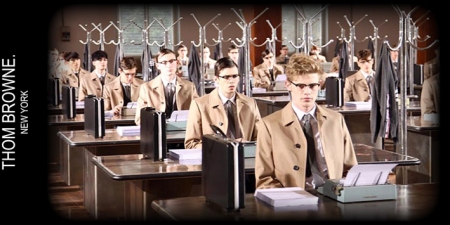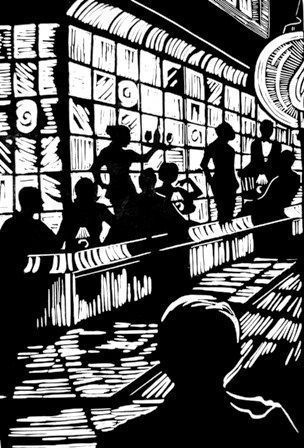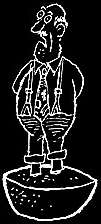We’ve re-branded the company and moved on to a new blog if you would be so kind as to click this most excellent link
Moving on
Posted in Uncategorized on January 18, 2011 by re: turn onBook brought to life
Posted in Inspiration, Videontology with tags stop motion on January 12, 2010 by re: turn onThis is such an impeccable, beautifully crafted example of stop motion that we simply had to post it. No critiques or pithy comments, just let the work speak for itself.
Produced by Londoners Andersen M Studio for Colenso BBDO NZ, “Going West” is some serious portfolio material, exemplifying the artist’s command of composition, chiaroscuro and technique. If anyone has seen anything comparable, please comment below.
Far from the Madding Crowd
Posted in digitalent, Inspiration, Music Clips, Videontology with tags concert, concert film, creative commons, crowd-source, crowdsource, crowdsourcing, film, mashup, NIN, Nine Inch Nails, Trent Reznor, ugc, video, youtube on January 7, 2010 by re: turn on
Whether you like his music or not, you have to give props to Trent Reznor for his balls, flying in the face of music industry copyright convention and giving labels the finger. In 2008 he privately releases the mammoth Nine Inch Nails album Ghosts with a Creative Commons Attribution-Noncommercial-Share Alike license. Three days ago he announces the imminent release of concert film “Another Version of the Truth: The Gift”, whose post-production was entirely crowdsourced to fans. NIN’s 2008 tour Lights in the Sky was shot professionally, but without a distribution deal to finance post-production, a finished film looked unlikely. Instead, Reznor released 405gb of raw footage freely online for his enthusiastic fanbase to edit and soundmix. They self-organised into an online collective called This One is On Us to crowdsource the production of a concert film that would have been a herculean task for even the most robust studio.
The inspiration originally came from “The Downward Spiral: Live at Webster Hall“, a concert film that was entirely crowdsourced from camera to DVD. I’ve long been a proponent of artists and corporations relaxing their copyright to accommodate the rising mash-up symbiosis (see my guest post for Julian Cole’s top blog Adspace Pioneers) and Trent Reznor continues to make my case for me. First he instates an open camera policy, rare for popular artists afraid their dubious talent might be shipwrecked upon the great ocean of YouTube. Webster Hall asked exorbitant fees for allowing crews to film, but they couldn’t police fans who brought their own cameras (that’s a copyright issue usually of concern solely to the performer/s). NIN’s open camera goodwill was reciprocated by fans, who aggregated footage from camera phones and video cameras, crowdsourced post-production and authored DVDs and torrent streams.
Artists take note: THE FUTURE IS NOW PRESENT
You lock yourselves in castles and build ramparts around your precious copyright, hoarding it away from the peasants who toil in your fields. You’re feudalists living in an anarcho-syndicalist commune. Just ask Dennis…
Fashion Film, the new surrealism?
Posted in Fashion, Videontology with tags Gareth Pugh, Luis Bunuel, SHOWstudio, YSL on November 26, 2009 by re: turn onReal fashion film isn’t just an afterthought, a mere video of a catwalk show or installation, it must stand on its own as a representation of the designer’s vision and inspiration. Some fashion films are triumphs of experimental film, like Luis Bunuel with a HiDef camera.
A Shaded View on Fashion Film started in Paris and now travels the world for fashion weeks in Seoul, London and Tokyo.
Gareth Pugh’s fashion film for his Autumn/Winter collection took top honours last month at A Shaded View on Fashion Film, produced by leading fashion film creators ShowStudio. The very definition of austere; a silhouetted outfit billows in black over a white background, a model’s hair dissolves to ink (a popular visual at the moment, as seen in the latest Nissan TVC), lots of treadmill model walking and the hackneyed old mirrored split screen. These visual motifs have been done better before. The opening silhouette zooms into full frame with the feet distractingly cut off, there are some clunky cross-fades and the ink is unconvincingly composited and masked. When filming an ink drop into water, the water ripples cause the image of the ink drop to shake. An image stabilization in post is usually required to correct the water ripple, but is noticeably absent here, so there’s a stable model and an incongruously shaky ink drop.
However, the ‘slice’ motif is pretty cool, first appearing subtly at 40 seconds with variations occurring throughout. At 5 minutes 41 seconds the film visually switches to an under-illuminated series of still poses and understated movements lit by a single swinging lamp just out of frame. Its a lovely counterpoint to the over-lit cyclorama that precedes and follows.
But there’s the distinct impression that this was a “shoot first, ask questions later” kind of production, where the director had only a vague notion of how she wanted the finished film to look when directing the shoot. Fashion films are free to be a visually experimental mindfuck, but if the only connective tissue is the designer’s garments, audience interest will be limited to the fashion community. Connective tissue is woven in a script outlining a concrete theme, without that your stuck bullshitting your way through post-production. I don’t see why fashion films, even those ostensibly intended for the catwalk, shouldn’t transcend the fashionista demo. Luis Bunuel brought surrealist cinema to the mainstream with Un chien Andalou in 1929, a palimpsest of social and religious iconography sketched with a thick ink of existential dread. Similarly expressionistic, fashion film can be a contemporary aeolian harp played by the winds of our malaise and aspirations. ShowStudio and YSL’s 24hrs is proof its possible.
Blog back in 5
Posted in Projects on September 25, 2009 by re: turn onFashion’s Audio Visual Gestalt
Posted in Fashion, Videontology with tags Audio Visual Gestalt, Fashion, Fashion Film, online video, Oyster Magazine, Pitti Uomo, SHOWstudio, Thom Browne, video, video installation, Viktor & Rolf, youtube, Yves saint Laurent on July 6, 2009 by re: turn onPhotography is the principal medium for documenting and expressing fashion. But film is the only medium that portrays the fall, flow and form of garments; the step and gait of shoes; the light, weight and movement of accessories. Encompassing all art forms in an audio visual gestalt, film is able to succinctly express a label’s complete artistic vision and reference inspirations. Some designers and labels are already way ahead of the curve.

Thom Browne’s installation at the Pitti Uomo menswear fair earlier this year was captured as a celebrated fashion film, simply evoking a 60’s business style reminiscent of Mad Men. The production design is impeccable. 40 identically dressed models arrive for work with military precision to antique typewriters on sparse clerks’ desks. The Istituto di Scienze Militari Aeronatiche in Florence provided the perfect location, with its parquetry floors and art deco design unchanged since it was built in 1938.

My favorite fashion film remains 24hrs, an epic series of innovative visual motifs for Yves saint Laurent in 2007, with a unique video for every hour of the day. SHOWstudio called for YSL admirers to submit treatments for each hour’s section and shot it live for broadcast on BBC and streaming from YSL’s website.

Oyster Magazine, the Australian based international fashion mag, launched Oystervision in early 2007 as an online video channel for fashion. As with its magazine counterpart, Oystervision covers emerging designers and major fashion events, but also produces fashion films for designers and labels who want an audio visual gestalt of their own. Established by colleague/buddy Alex Goddard, I helped out with the early episodes, covering Gail Sorronda’s debut show and Kit Willow’s wickedly sexy Helmut Newton inspired lingerie installation.
on productions did a seasonal retrospective for fashion retailer Barkins called “Dollhouses”. A distinct fashion film was created from footage originally shot for the year’s TVCs, using a technique I developed called “composicam”. (From our fashion showreel – the 1st minute 30 seconds is Barkins “Dollhouses”, the rest is RAFW 2008).
FASHION FILM FOIBLES?
Fashion films generally disappoint in their online implementation, where they ultimately draw most eyes. Most fashion films are simply embedded into the label’s website, on a functional yet uninspired page. With their virtual salon, Viktor & Rolf demonstrated that streaming video and website should be aesthetically harmonious. The online experience need not be elaborate and expensive, if the website is an elegant expression of the label’s style, the fashion film should be produced to complement it.
YouTube is also curiously neglected by labels with fashion films. There may be a marketing rationale for restricting video to the label’s website, like maintaining exclusivity or controlling consumer traffic. But YouTube has vast potential to augment the audience for fashion film and increase the label’s exposure. YouTube has a built in audience that will broaden the reach of a fashion film and enable easy sharing. Labels can generate additional traffic to their website by linking back from their YouTube channel, which equates to revenue for transactional sites. The ability to freely embed video encourages blogs (like Vogue’s blogs worldwide) and online publications to further spread fashion film. YouTube serves as a social media platform, a means of engaging admirers/fans/customers and encouraging conversation. And that is, like so hot right now.
Julian Cole wrote a great rundown on 15 fashion retailers successfully employing social media strategies in his blog Adspace Pioneers.
World, meet Reggae
Posted in Music Clips with tags Desmond Dekker, Israelites, live music, music clip, reggae on June 30, 2009 by re: turn on40 years ago this month, Desmond Dekker and The Aces introduced the world to Jamaican music with their reggae classic “Israelites”.
Catchier than swine flu, “Israelites” is also a profound meditation on the parallels between Jamaican poverty and the starved desert wanderings of the Hebrews chronicled in Exodus from the Old Testament. Despite complaints that Dekker’s thick Kingston accent made lyrics difficult to understand, the track reached #9 in the US and #1 in the UK.
If that toe-tapping foot-flapping bass-line arpeggio sounds vaguely familiar, you may be recognizing its influence on The Beatles’ “Ob-La-Di, Ob-La-Da”, where they lyrically reference Desmond Dekker.
I’m a big fan of the art of the music clip, but this video exemplifies why live performance can often be more compelling, particularly as a verite record of history. Shot by the BBC the year following its release, the Brits in the audience are clearly having fun, but are unsure how to transfer “Israelites” infectious rhythm to their feet.
The photography is excellent, soft focus beautifully diffuses the stage lights, slightly overexposed so that Dekker’s funky bodysuit literally glows. A long dolly shot tracks behind the audience, tables and pillars; effectively establishing place, with a few bumps excusable given the live and crowded circumstances. Some shots use depth of field to show an old schooner glass on a bar, more drained with each edit (I reckon the cameraman was sneaking an ale).
Then there’s the performance, for which I’m at a loss for words…
Video as History
Posted in Videontology with tags film as history, Iran Election, Neda, Neda Agha-Soltan, political film, political video, Tehran, video on June 23, 2009 by re: turn onI’m finding it difficult to reconcile my conflicted emotions about Neda Agha-Soltan‘s shooting death during the Iran election protests, which was captured on video and went viral on YouTube.
As her mouth and nose pours blood from her punctured lung, she looks up to the camera capturing her final moments. I believe that she was aware that her death will be seen by the world. She’s imploring us with her eyes. Its hard to meet her gaze, yet hard to look away.
If Ahmadinejad and Iran’s clerical elite capitulate to the overwhelming call for democracy from their people and the world, this video will be emblematic of that struggle.
Film has long been tied to political and sociological movement. In 1925 Eisenstein’s The Battleship Potempkin influenced the shift from individualism to collectivism, following Russia’s socialist revolution. Leni Riefenstahl’s Triumph of the Will was instrumental in whipping up nationalist fervour in support of the Nazi party’s military aggression that culminated in WWII. The assassination of JFK captured by Zapruder‘s little 8mm camera sparked public paranoia that would define 70’s America. The student at Tienamin Square halting the line of tanks as the moment the rest of the world became cognizant of China’s tyrannical rule. The many amateur videos of 9/11 defined the moment in history when the West’s complacency turned into fear and aggression. Now Neda bleeding to death on the street in Tehran will be the moment in history when the Middle East’s most powerful nation revealed its black heart.
Zapruder’s film of the JFK assassination both defined and changed history, as the only public evidence of what happened that day in Texas and an iconic image that moved the world. History as recorded is interpretative. It is written by the victor to be as palatable as possible to the status quo. The staging of the flag raising at Iwo Jima for the sake of a photo might also be possible with video, but there is one factor favoring video as a true record of history. Video’s ubiquity makes it democratic, even in a country without democracy like Iran. Anyone can capture an historical moment on their phone or video camera and distribute it online, just as has happened with the unjust death of Neda. With the decline of library use, we are increasingly watching video as a record of history.
As I write in the comfort and safety of my office, how does watching her death ethically implicate me? I’m trying not to rubberneck like I’m driving past the aftermath of a car crash. I’m trying to provoke discussion and anger over her unnecessary death at the hands of a regime that evidently must stand down. But I’m also voyeur to a moment of utmost intimacy. Could Neda also be imploring us to look away?
Elevator to Heaven or Hell
Posted in Videontology with tags CGI, compositing, flame artist, Marco Brambilla, video installation, youtube on June 18, 2009 by re: turn onVideontology may seem a little focused on online video, but I ♥ all aspects and mediums of moving images. Italian video artist Marco Brambilla has a daunting body of work behind him. He recently collaborated with design studio Crush on an installation called “Civilization” that is staggering in its lavish aesthetic, complex application and simple execution.
A visual depiction of Dante’s Divine Comedy, “Civilization” is installed in the elevators of the Standard hotel in NY, synchronously panning up and down with the movement of the elevator. At street level you get Inferno and the penthouses are Paradiso, subtly encouraging premium bookings.
In keeping with Dante’s self-referential flourishes, Marco Brambilla selected familiar images from films like Zack Snider’s Dawn of the Dead and 300, Mel Brooks’ To Be or Not To Be, Star Wars, Dark City, Jacques Tati’s Playtime, Ghostbusters and too many more to mention. Along with stock footage and stills, he collated materials over three months and worked with Crush for another 6 weeks (after hours given the budget of the project) to create a 2D draft that would subsequently be rendered into a 3D vertical plane by Flame artists. CGI like fireballs and lighting were also rendered in Flame.
Its by no means perfect; some of the loops are distractingly clunky, the train and rollercoaster just disappear or fade out, the depth ascribed to 3D planes occasionally looks unconvincing and composited elements’ colour grading is inconsistent. But these are minor quibbles, given Civilization’s epic scope and visual opulence, not to mention its novel application.
You can read more from Marco Brambilla and Crush on “Civilization” here.


 In his blog
In his blog 


